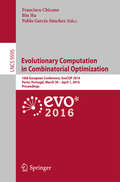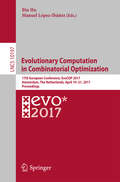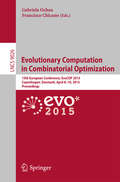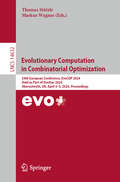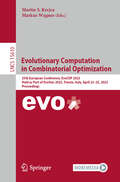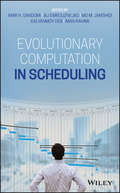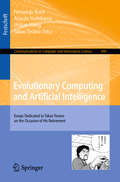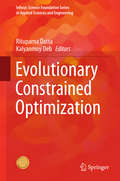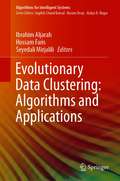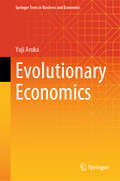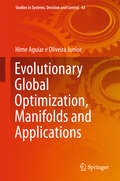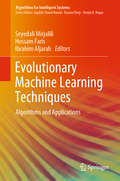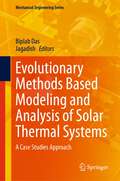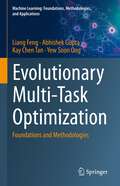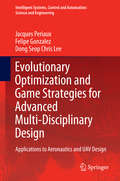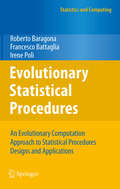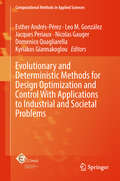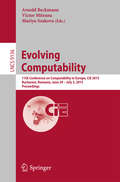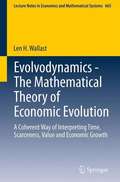- Table View
- List View
Evolutionary Bioinformatics
by Donald R. ForsdykeNow in its third edition and supplemented with more online material, this book aims to make the "new" information-based (rather than gene-based) bioinformatics intelligible both to the "bio" people and the "info" people. Books on bioinformatics have traditionally served gene-hunters, and biologists who wish to construct family trees showing tidy lines of descent. While dealing extensively with the exciting topics of gene discovery and database-searching, such books have hardly considered genomes as information channels through which multiple forms and levels of information have passed through the generations. This "new bioinformatics" contrasts with the "old" gene-based bioinformatics that so preoccupies previous texts. Forms of information that we are familiar with (mental, textual) are related to forms with which we are less familiar (hereditary). The book extends a line of evolutionary thought that leads from the nineteenth century (Darwin, Butler, Romanes, Bateson), through the twentieth (Goldschmidt, White), and into the twenty first (the final works of the late Stephen Jay Gould). Long an area of controversy, diverging views may now be reconciled.
Evolutionary Computation 1: Basic Algorithms and Operators (Ieee Press Series On Computational Intelligence Ser. #1)
by Thomas Baeck D. B Fogel Z MichalewiczThe field of evolutionary computation is expanding dramatically, fueled by the vast investment that reflects the value of applying its techniques. Culling material from the Handbook of Evolutionary Computation, Evolutionary Computation 1: Basic Algorithms and Operators contains up-to-date information on algorithms and operators used in evolutionary computing. This volume discusses the basic ideas that underlie the main paradigms of evolutionary algorithms, evolution strategies, evolutionary programming, and genetic programming. It is intended to be used by individual researchers, teachers, and students working and studying in this expanding field.
Evolutionary Computation in Combinatorial Optimization
by Bin Hu Francisco Chicano Pablo García-SánchezThisbook constitutes the refereed proceedings of the 16th European Conference onEvolutionary Computation in Combinatorial Optimization, EvoCOP 2016, held in Porto,Portugal, in March/April 2016, co-located with the Evo*2015 events EuroGP,EvoMUSART and EvoApplications. The17 revised full papers presented were carefully reviewed and selected from 44submissions. The papers cover methodology, applications and theoretical studies. Themethods included evolutionary and memetic algorithms, variable neighborhoodsearch, particle swarm optimization, hyperheuristics, mat-heuristic and otheradaptive approaches. Applications included both traditional domains, such asgraph coloring, vehicle routing, the longest common subsequence problem, thequadratic assignment problem; and new(er) domains such as the traveling thiefproblem, web service location, and finding short addition chains. Thetheoretical studies involved fitness landscape analysis, local search and recombinationoperator analysis, and the big valley search space hypothesis. Theconsideration of multiple objectives, dynamic and noisy environments was alsopresent in a number of articles.
Evolutionary Computation in Combinatorial Optimization
by Bin Hu Manuel López-IbáñezThis book constitutes the refereed proceedings of the 16th European Conference on Evolutionary Computation in Combinatorial Optimization, EvoCOP 2016, held in Porto, Portugal, in March/April 2016, co-located with the Evo*2015 events EuroGP, EvoMUSART and EvoApplications. The 17 revised full papers presented were carefully reviewed and selected from 44 submissions. The papers cover methodology, applications and theoretical studies. The methods included evolutionary and memetic algorithms, variable neighborhood search, particle swarm optimization, hyperheuristics, mat-heuristic and other adaptive approaches. Applications included both traditional domains, such as graph coloring, vehicle routing, the longest common subsequence problem, the quadratic assignment problem; and new(er) domains such as the traveling thief problem, web service location, and finding short addition chains. The theoretical studies involved fitness landscape analysis, local search and recombination operator analysis, and the big valley search space hypothesis. The consideration of multiple objectives, dynamic and noisy environments was also present in a number of articles.
Evolutionary Computation in Combinatorial Optimization
by Francisco Chicano Gabriela OchoaThis book constitutes the refereed proceedings of the 15th European Conference on Evolutionary Computation in Combinatorial Optimization, EvoCOP 2015, held in Copenhagen, Denmark, in April 2015, co-located with the Evo*2015 events EuroGP, EvoMUSART and EvoApplications. The 19 revised full papers presented were carefully reviewed and selected from 46 submissions. The papers cover methodology, applications and theoretical studies. The methods included evolutionary and memetic (hybrid) algorithms, iterated local search, variable neighbourhood search, ant colony optimization, artificial immune systems, hyper-heuristics and other adaptive approaches. The applications include both traditional domains, such as graph coloring, knapsack, vehicle routing, job-shop scheduling, the p-median and the orienteering problems; and new(er) domains such as designing deep recurrent neural networks, detecting network community structure, lock scheduling of ships, cloud resource management, the fire-fighter problem and AI planning. The theoretical studies involved approximation ratio, runtime and black-box complexity analyses.
Evolutionary Computation in Combinatorial Optimization: 24th European Conference, EvoCOP 2024, Held as Part of EvoStar 2024, Aberystwyth, UK, April 3–5, 2024, Proceedings (Lecture Notes in Computer Science #14632)
by Thomas Stützle Markus WagnerThis book constitutes the referred proceedings of the 24th European Conference on Evolutionary Computation in Combinatorial Optimization, EvoCOP 2024, held as part of EvoStar 2024, in Aberystwyth, UK, during April 3–5, 2024. The 12 full papers presented in this book were carefully reviewed and selected from 28 submissions. They cover a variety of topics, ranging from constructive algorithms, machine learning techniques ranging from neural network based guidance to sparse surrogate models for optimization problems, the foundation of evolutionary computation algorithms and other search heuristics, to multi-objective optimization problems.
Evolutionary Computation in Combinatorial Optimization: 25th European Conference, EvoCOP 2025, Held as Part of EvoStar 2025, Trieste, Italy, April 23–25, 2025, Proceedings (Lecture Notes in Computer Science #15610)
by Markus Wagner Martin S. KrejcaThis book constitutes the referred proceedings of the 25th European Conference on Evolutionary Computation in Combinatorial Optimization, EvoCOP 2025, held as part of EvoStar 2025, in Trieste, Italy, during April 23–25, 2025.The 16 full papers presented in this book were carefully reviewed and selected from 43 submissions. These papers cover a variety of topics, ranging from benchmark creation, over genetic programming, heuristics for real-world and NP-hard problems, as well as the foundations of evolutionary computation algorithms and other search heuristics, to both mixed-binary and multi-objective optimization.
Evolutionary Computation in Gene Regulatory Network Research
by Nasimul Noman Hitoshi IbaIntroducing a handbook for gene regulatory network research using evolutionary computation, with applications for computer scientists, computational and system biologists This book is a step-by-step guideline for research in gene regulatory networks (GRN) using evolutionary computation (EC). The book is organized into four parts that deliver materials in a way equally attractive for a reader with training in computation or biology. Each of these sections, authored by well-known researchers and experienced practitioners, provides the relevant materials for the interested readers. The first part of this book contains an introductory background to the field. The second part presents the EC approaches for analysis and reconstruction of GRN from gene expression data. The third part of this book covers the contemporary advancements in the automatic construction of gene regulatory and reaction networks and gives direction and guidelines for future research. Finally, the last part of this book focuses on applications of GRNs with EC in other fields, such as design, engineering and robotics. * Provides a reference for current and future research in gene regulatory networks (GRN) using evolutionary computation (EC) * Covers sub-domains of GRN research using EC, such as expression profile analysis, reverse engineering, GRN evolution, applications * Contains useful contents for courses in gene regulatory networks, systems biology, computational biology, and synthetic biology * Delivers state-of-the-art research in genetic algorithms, genetic programming, and swarm intelligence Evolutionary Computation in Gene Regulatory Network Research is a reference for researchers and professionals in computer science, systems biology, and bioinformatics, as well as upper undergraduate, graduate, and postgraduate students. Hitoshi Iba is a Professor in the Department of Information and Communication Engineering, Graduate School of Information Science and Technology, at the University of Tokyo, Toyko, Japan. He is an Associate Editor of the IEEE Transactions on Evolutionary Computation and the journal of Genetic Programming and Evolvable Machines. Nasimul Noman is a lecturer in the School of Electrical Engineering and Computer Science at the University of Newcastle, NSW, Australia. From 2002 to 2012 he was a faculty member at the University of Dhaka, Bangladesh. Noman is an Editor of the BioMed Research International journal. His research interests include computational biology, synthetic biology, and bioinformatics.
Evolutionary Computation in Scheduling
by Kalyanmoy Deb Ali Emrouznejad Amir H. Gandomi Mo M. Jamshidi Iman RahimiPresents current developments in the field of evolutionary scheduling and demonstrates the applicability of evolutionary computational techniques to solving scheduling problems This book provides insight into the use of evolutionary computations (EC) in real-world scheduling, showing readers how to choose a specific evolutionary computation and how to validate the results using metrics and statistics. It offers a spectrum of real-world optimization problems, including applications of EC in industry and service organizations such as healthcare scheduling, aircraft industry, school timetabling, manufacturing systems, and transportation scheduling in the supply chain. It also features problems with different degrees of complexity, practical requirements, user constraints, and MOEC solution approaches. Evolutionary Computation in Scheduling starts with a chapter on scientometric analysis to analyze scientific literature in evolutionary computation in scheduling. It then examines the role and impacts of ant colony optimization (ACO) in job shop scheduling problems, before presenting the application of the ACO algorithm in healthcare scheduling. Other chapters explore task scheduling in heterogeneous computing systems and truck scheduling using swarm intelligence, application of sub-population scheduling algorithm in multi-population evolutionary dynamic optimization, task scheduling in cloud environments, scheduling of robotic disassembly in remanufacturing using the bees algorithm, and more. This book: Provides a representative sampling of real-world problems currently being tackled by practitioners Examines a variety of single-, multi-, and many-objective problems that have been solved using evolutionary computations, including evolutionary algorithms and swarm intelligence Consists of four main parts: Introduction to Scheduling Problems, Computational Issues in Scheduling Problems, Evolutionary Computation, and Evolutionary Computations for Scheduling Problems Evolutionary Computation in Scheduling is ideal for engineers in industries, research scholars, advanced undergraduates and graduate students, and faculty teaching and conducting research in Operations Research and Industrial Engineering.
Evolutionary Computing and Artificial Intelligence: Essays Dedicated to Takao Terano on the Occasion of His Retirement (Communications in Computer and Information Science #999)
by Fernando Koch Takao Terano Atsushi Yoshikawa Shihan WangThis Festschrift volume is published in honor of Takao Terano on the occasion of his retirement. Takao Terano is a leading expert in the areas of agent-based modelling, knowledge systems, evolutionary computation, and service science.The contributions in this volume reflect the breadth and impact of his work. The volume contains 12 full papers related to Takao Terano’s research. They deal with various aspects of artificial intelligence, multi-agent systems, collaborative and social computing, social networks, ubiquitous computing.
Evolutionary Constrained Optimization
by Kalyanmoy Deb Rituparna DattaThis book makes available a self-contained collection of modern research addressing the general constrained optimization problems using evolutionary algorithms. Broadly the topics covered include constraint handling for single and multi-objective optimizations; penalty function based methodology; multi-objective based methodology; new constraint handling mechanism; hybrid methodology; scaling issues in constrained optimization; design of scalable test problems; parameter adaptation in constrained optimization; handling of integer, discrete and mix variables in addition to continuous variables; application of constraint handling techniques to real-world problems; and constrained optimization in dynamic environment. There is also a separate chapter on hybrid optimization, which is gaining lots of popularity nowadays due to its capability of bridging the gap between evolutionary and classical optimization. The material in the book is useful to researchers, novice, and experts alike. The book will also be useful for classroom teaching and future research.
Evolutionary Data Clustering: Algorithms and Applications (Algorithms for Intelligent Systems)
by Seyedali Mirjalili Hossam Faris Ibrahim AljarahThis book provides an in-depth analysis of the current evolutionary clustering techniques. It discusses the most highly regarded methods for data clustering. The book provides literature reviews about single objective and multi-objective evolutionary clustering algorithms. In addition, the book provides a comprehensive review of the fitness functions and evaluation measures that are used in most of evolutionary clustering algorithms. Furthermore, it provides a conceptual analysis including definition, validation and quality measures, applications, and implementations for data clustering using classical and modern nature-inspired techniques. It features a range of proven and recent nature-inspired algorithms used to data clustering, including particle swarm optimization, ant colony optimization, grey wolf optimizer, salp swarm algorithm, multi-verse optimizer, Harris hawks optimization, beta-hill climbing optimization. The book also covers applications of evolutionary data clustering in diverse fields such as image segmentation, medical applications, and pavement infrastructure asset management.
Evolutionary Economics (Springer Texts in Business and Economics)
by Yuji ArukaThis textbook presents a new way to visualize or imagine the evolutionary architecture of economics, to judge both its practical outcomes and its ultimate value. Evolutionary economics employs an Aristotelian architecture. The cognitive value of this imagination[H1] must be directly relevant to the evolutionary theory and practice of designing the architecture of the economic system. Mainstream economics completely ignores design value in order to concentrate on the ideal, Platonic vision of the economy. The current system is no longer one that converges on a constant entity, because the system is constantly evolving. The advent of the digital economy is an indispensable next step, and computational power and algorithmic rationality are increasingly dominating the economic system—and complicating it. In today’s society, neither fault nor malice matters in the algorithmic or human system. There is little room left for the effective working of human reason. Correspondingly, the meanings of money, exchange, the market system, auctions, production, consumption, and the currency transaction system are poised to change. In most cases, there will be digital counterparts. A smart contract tied together with DLT, for example, makes it possible to design an economically well-behaved peer-to-peer (P2P) system, which ranges from the micromarket to the international currency transaction system. The introduction of this technology and its architectural design may suggest what a truly decentralized future entails. This change may also bring about a new understanding of existing social consensus and practice. Thus, the implementation of these considerations naturally leads to a new style of chapter structuring in this book, from the classical analytical approach to exploring computational methods and digital tools: in many cases, the problems presented in each chapter are combined with discussions of a respective computational method and its practical value.
Evolutionary Games in Complex Topologies
by Julia Poncela CasasnovasThere are many examples of cooperation in Nature: cells cooperate to form tissues, organs cooperate to form living organisms, and individuals cooperate to raise their offspring or to hunt. However, why cooperation emerges and survives in hostile environments, when defecting would be a much more profitable short-term strategy, is a question that still remains open. During the past few years, several explanations have been proposed, including kin and group selection, punishment and reputation mechanisms, or network reciprocity. This last one will be the center of the present study. The thesis explores the interface between the underlying structure of a given population and the outcome of the cooperative dynamics taking place on top of it, (namely, the Prisoner's Dilemma Game). The first part of this work analyzes the case of a static system, where the pattern of connections is fixed, so it does not evolve over time. The second part develops two models for growing topologies, where the growth and the dynamics are entangled.
Evolutionary Games with Sociophysics: Analysis of Traffic Flow and Epidemics (Evolutionary Economics and Social Complexity Science #17)
by Jun TanimotoRecent applications of evolutionary game theory in the merging fields of the mathematical and social sciences are brilliantly portrayed in this book, which highlights social physics and shows how the approach can help to quantitatively model complex human–environmental–social systems.First, readers are introduced to the fundamentals of evolutionary game theory. The two-player, two-strategy game, or the 2 × 2 game, is presented as an archetype to help understand the difficulty of cooperating for survival against defection in common social contexts. Subsequently, the book explains the theoretical background of the multi-player, two-strategy game, which may be more widely applicable than the 2 × 2 game for social dilemmas. The latest applications of 2 × 2 games are also discussed to explore how integrated reciprocity mechanisms can solve social dilemmas.In turn, the book describes two practical areas in which evolutionary game theory has been applied. The first concerns traffic flow analysis. In conventional interpretations, traffic flow can be understood by means of fluid dynamics, in which the flow of vehicles is evaluated as a continuum body. Such a simple idea, however, does not work well in reality, particularly if a driver’s decision-making process is considered. Various dilemmas involve complex structures that depend primarily on traffic density, a revelation that should help establish a practical solution for reducing traffic congestion.Second, the book provides keen insights into how powerful evolutionary game theory can be in the context of epidemiology. Both approaches, quasi-analytical and multi-agent simulation, can clarify how an infectious disease such as seasonal influenza spreads across a complex social network, which is significantly affected by the public attitude toward vaccination. A methodology is proposed for the optimum design of a public vaccination policy incorporating subsidies to efficiently increase vaccination coverage while minimizing the social cost.
Evolutionary Gerontology and Geriatrics: Why and How We Age (Advances in Studies of Aging and Health #2)
by Giacinto Libertini Graziamaria Corbi Valeria Conti Olga Shubernetskaya Nicola FerraraThis book provides concrete scientific basis that we can conceive the possibility of modifying or even completely canceling aging process, despite the fact that aging is commonly regarded as the result of the overall effects of many uncontrollable degenerative phenomena. The authors illustrate in detail the mechanisms by which cells and the whole organism age. Actions by which it is possible, or will be possible within a limited time, to operate for modifying aging are also debated.The discussion is conducted within the frame and the concepts of evolutionary medicine, which is also indispensable for distinguishing between the manifestations of aging and: (i) diseases that worsen with age, and (ii) acceleration of normal aging rates, caused by unhealthy lifestyle habits and other avoidable factors. The book also discusses the impact of aging on overall mortality and the strange situation that, according to official statistics, aging does not exist as cause of death.This book is a turning point between a gerontology and geriatrics conceived as the study and vain treatment of an incurable condition and one in which these disciplines examine the how and why of a physiological phenomenon that can be modified up to a possible total control. This means transforming the medical prevention and treatment of physiological aging from the greatest failure to the greatest success of medicine.
Evolutionary Global Optimization, Manifolds and Applications
by Hime Aguiar e Oliveira JuniorThis book presents powerful techniques for solving global optimization problems on manifolds by means of evolutionary algorithms, and shows in practice how these techniques can be applied to solve real-world problems. It describes recent findings and well-known key facts in general and differential topology, revisiting them all in the context of application to current optimization problems. Special emphasis is put on game theory problems. Here, these problems are reformulated as constrained global optimization tasks and solved with the help of Fuzzy ASA. In addition, more abstract examples, including minimizations of well-known functions, are also included. Although the Fuzzy ASA approach has been chosen as the main optimizing paradigm, the book suggests that other metaheuristic methods could be used as well. Some of them are introduced, together with their advantages and disadvantages. Readers should possess some knowledge of linear algebra, and of basic concepts of numerical analysis and probability theory. Many necessary definitions and fundamental results are provided, with the formal mathematical requirements limited to a minimum, while the focus is kept firmly on continuous problems. The book offers a valuable resource for students, researchers and practitioners. It is suitable for university courses on optimization and for self-study.
Evolutionary Machine Learning Techniques: Algorithms and Applications (Algorithms for Intelligent Systems)
by Seyedali Mirjalili Hossam Faris Ibrahim AljarahThis book provides an in-depth analysis of the current evolutionary machine learning techniques. Discussing the most highly regarded methods for classification, clustering, regression, and prediction, it includes techniques such as support vector machines, extreme learning machines, evolutionary feature selection, artificial neural networks including feed-forward neural networks, multi-layer perceptron, probabilistic neural networks, self-optimizing neural networks, radial basis function networks, recurrent neural networks, spiking neural networks, neuro-fuzzy networks, modular neural networks, physical neural networks, and deep neural networks. The book provides essential definitions, literature reviews, and the training algorithms for machine learning using classical and modern nature-inspired techniques. It also investigates the pros and cons of classical training algorithms. It features a range of proven and recent nature-inspired algorithms used to train different types of artificial neural networks, including genetic algorithm, ant colony optimization, particle swarm optimization, grey wolf optimizer, whale optimization algorithm, ant lion optimizer, moth flame algorithm, dragonfly algorithm, salp swarm algorithm, multi-verse optimizer, and sine cosine algorithm. The book also covers applications of the improved artificial neural networks to solve classification, clustering, prediction and regression problems in diverse fields.
Evolutionary Methods Based Modeling and Analysis of Solar Thermal Systems: A Case Studies Approach (Mechanical Engineering Series)
by Jagadish Biplab DasThis book presents insights into the thermal performance of solar thermal collectors using both computational and experimental modeling. It consists of various computational and experimental case studies conducted by the authors on the solar thermal collector system. The authors begin by developing thermal modeling using a case study that shows the effect of different governing parameters. A few more experimental cases studies follow that highlight the energy, exergy, and environmental performance of the solar thermal collector system and to examine the performance of a modified solar collector system, illustrating performance improvement techniques. Finally, application of different evolutionary optimization techniques such as soft computing and evolutionary methods, like fuzzy techniques, MCDM methods like fuzzy logic based expert system (FLDS), Artificial Neural Network (ANN), Grey relational analysis (GRA), Entropy-Jaya algorithm, Entropy-VIKOR etc. are employed.
Evolutionary Multi-Task Optimization: Foundations and Methodologies (Machine Learning: Foundations, Methodologies, and Applications)
by Abhishek Gupta Kay Chen Tan Yew Soon Ong Liang FengA remarkable facet of the human brain is its ability to manage multiple tasks with apparent simultaneity. Knowledge learned from one task can then be used to enhance problem-solving in other related tasks. In machine learning, the idea of leveraging relevant information across related tasks as inductive biases to enhance learning performance has attracted significant interest. In contrast, attempts to emulate the human brain’s ability to generalize in optimization – particularly in population-based evolutionary algorithms – have received little attention to date. Recently, a novel evolutionary search paradigm, Evolutionary Multi-Task (EMT) optimization, has been proposed in the realm of evolutionary computation. In contrast to traditional evolutionary searches, which solve a single task in a single run, evolutionary multi-tasking algorithm conducts searches concurrently on multiple search spaces corresponding to different tasks or optimization problems, each possessing a unique function landscape. By exploiting the latent synergies among distinct problems, the superior search performance of EMT optimization in terms of solution quality and convergence speed has been demonstrated in a variety of continuous, discrete, and hybrid (mixture of continuous and discrete) tasks. This book discusses the foundations and methodologies of developing evolutionary multi-tasking algorithms for complex optimization, including in domains characterized by factors such as multiple objectives of interest, high-dimensional search spaces and NP-hardness.
Evolutionary Optimization and Game Strategies for Advanced Multi-Disciplinary Design
by Jacques Periaux Felipe Gonzalez Dong Seop Chris LeeMany complex aeronautical design problems can be formulated with efficient multi-objective evolutionary optimization methods and game strategies. This book describes the role of advanced innovative evolution tools in the solution, or the set of solutions of single or multi disciplinary optimization. These tools use the concept of multi-population, asynchronous parallelization and hierarchical topology which allows different models including precise, intermediate and approximate models with each node belonging to the different hierarchical layer handled by a different Evolutionary Algorithm. The efficiency of evolutionary algorithms for both single and multi-objective optimization problems are significantly improved by the coupling of EAs with games and in particular by a new dynamic methodology named "Hybridized Nash-Pareto games". Multi objective Optimization techniques and robust design problems taking into account uncertainties are introduced and explained in detail. Several applications dealing with civil aircraft and UAV, UCAV systems are implemented numerically and discussed. Applications of increasing optimization complexity are presented as well as two hands-on test cases problems. These examples focus on aeronautical applications and will be useful to the practitioner in the laboratory or in industrial design environments. The evolutionary methods coupled with games presented in this volume can be applied to other areas including surface and marine transport, structures, biomedical engineering, renewable energy and environmental problems. This book will be of interest to students, young scientists and engineers involved in the field of multi physics optimization.
Evolutionary Statistical Procedures
by Irene Poli Roberto Baragona Francesco BattagliaThis proposed text appears to be a good introduction to evolutionary computation for use in applied statistics research. The authors draw from a vast base of knowledge about the current literature in both the design of evolutionary algorithms and statistical techniques. Modern statistical research is on the threshold of solving increasingly complex problems in high dimensions, and the generalization of its methodology to parameters whose estimators do not follow mathematically simple distributions is underway. Many of these challenges involve optimizing functions for which analytic solutions are infeasible. Evolutionary algorithms represent a powerful and easily understood means of approximating the optimum value in a variety of settings. The proposed text seeks to guide readers through the crucial issues of optimization problems in statistical settings and the implementation of tailored methods (including both stand-alone evolutionary algorithms and hybrid crosses of these procedures with standard statistical algorithms like Metropolis-Hastings) in a variety of applications. This book would serve as an excellent reference work for statistical researchers at an advanced graduate level or beyond, particularly those with a strong background in computer science.
Evolutionary and Deterministic Methods for Design Optimization and Control With Applications to Industrial and Societal Problems (Computational Methods in Applied Sciences #49)
by Nicolas Gauger Kyriakos Giannakoglou Jacques Periaux Domenico Quagliarella Esther Andrés-Pérez Leo M. GonzálezThis book contains thirty-five selected papers presented at the International Conference on Evolutionary and Deterministic Methods for Design, Optimization and Control with Applications to Industrial and Societal Problems (EUROGEN 2017). This was one of the Thematic Conferences of the European Community on Computational Methods in Applied Sciences (ECCOMAS). Topics treated in the various chapters reflect the state of the art in theoretical and numerical methods and tools for optimization, and engineering design and societal applications. The volume focuses particularly on intelligent systems for multidisciplinary design optimization (mdo) problems based on multi-hybridized software, adjoint-based and one-shot methods, uncertainty quantification and optimization, multidisciplinary design optimization, applications of game theory to industrial optimization problems, applications in structural and civil engineering optimum design and surrogate models based optimization methods in aerodynamic design.
Evolving Computability
by Arnold Beckmann Victor Mitrana Mariya SoskovaThis book constitutes the refereed proceedings of the 11th Conference on Computability in Europe, CiE 2015, held in Bucharest, Romania, in June/July 2015. The 26 revised papers presented were carefully reviewed and selected from 64 submissions and included together with 10 invited papers in this proceedings. The conference CiE 2015 has six special sessions: two sessions, Representing Streams and Reverse Mathematics, were introduced for the first time in the conference series. In addition to this, new developments in areas frequently covered in the CiE conference series were addressed in the further special sessions on Automata, Logic and Infinite Games; Bio-inspired Computation; Classical Computability Theory; as well as History and Philosophy of Computing.
Evolvodynamics - The Mathematical Theory of Economic Evolution
by Len H. WallastDissatisfied with the flaws of orthodox economics, the author proposes to base economic theory on the three principles of Darwinian evolution (variation, inheritance, selection). Pursuing a suggestion of E.T. Jaynes of 1991, the innovation is in treating economic behavior as chance events of selection. This involves abandoning the methods of mainstream economics and to apply instead the methods by which Claude E. Shannon analyzed information transport over a stationary channel. As economic processes are non-stationary, the author clarifies first how the Shannon-system must be reshaped in a system capable to describe economic evolution mathematically. As economic processes are non-stationary, the author first clarifies how the Shannon system must be reshaped into one capable of describing economic evolutions mathematically. Deriving the universal relations between input, output, the economic growth rate, inflation and money flow involves applying differential sets of selection, Venn diagrams, bitpulses as units of selection and the probability distributions of bitpulses. This is a thought-provocative and highly informative book of which the explanatory power goes far beyond that of traditional economics. It should be on the readers list of everyone concerned with the weal and woe of economic theorizing.


